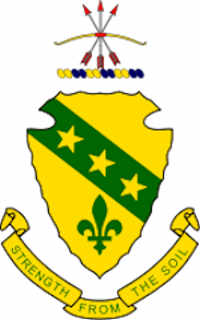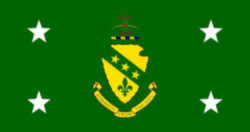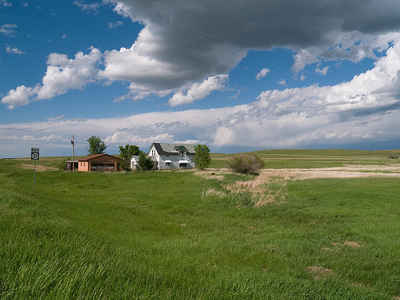North Dakota State Coat of Arms
Coat of Arms

Adopted in 1957.
The Legislative Assembly passed H.B. No. 822 sponsored by Representatives Clifford Lindberg and Gillman Olson to create the North Dakota coat of arms (1957 S.L., ch. 330).
the Governor is using the coat of arms as a flag there must be a white star placed in each of the four corners (North Dakota Century Code Section 54-41-04).
The North Dakota coat of arms was displayed for the first time by the National Guard at Camp Grafton on June 16, 1957.
North Dakota State Coat of Arms: Coat of Arms

The coat of arms of North Dakota was created for use by the state government and National Guard units
Heraldic Description
Section 54-41-01 of the North Dakota Century Code specifies the design (blazon) of the coat of arms thus;
Device: On an Indian arrowhead point to base Or a bend vert charged with three mullets of the first, in base a fleur-de-lis of the
second.
Crest: On a wreath Or and azure, a sheaf of three arrows argent armed and flighted gules behind a stringed bow fessways Or with grip
of the second (gules).
Motto: Strength from the soil.
Allusions
The allusions made in the arms are laid down in section 54-41-02 NDCC:
The colors of yellow gold and green are indicative of the great agricultural state of North Dakota and has particular reference to ripening grain and
the abundant grazing areas. The Indian arrowhead forms the shield of the coat of arms and symbolizes the "Sioux State." The three stars denote
the trinity of government; legislative, executive, and judicial. Each star in the bend is given the heraldic value of thirteen which signifies the
thirteen original colonies of the United States, and the cumulative numerical value of the three stars indicates that North Dakota was the thirty-ninth
state admitted to the Union. The stars also allude to the history of the territory under three foreign flags. Three stars are borne upon the coat of
arms of Meriwether Lewis of the Lewis and Clark expedition and also on the coat of arms of Lord Selkirk, head of the first permanent settlement in
this state. The fleur-de-lis alludes to La Verendrye, a Canadian explorer who was the first known white man to visit the territory of this state. The
blue and gold wreath in the crest reflects the history of the territory as part of the Louisiana purchase. The crest which shall constitute the military
crest of the state of North Dakota is a motif taken from the state seal and to the Sioux Indian tribes signifies mighty warriors.
North Dakota Law
The law the official North Dakota state Coat of Arms is found in the North Dakota Revised Statutes, Title 54, Chapter 54-02, Section 54-41 thru Section 54-44
Title 54
Chapter 54-41 Dakota Coat of Arms:
54-41-01. Designation of coat of arms. A coat of arms of the state of North Dakota is designated and described as follows:
Device: On an Indian arrowhead point to base or a bend vert charged with three mullets of the first,
in base a fleur-de-lis of the second.
Crest: On a wreath or and azure, a sheaf of three arrows argent armed and flighted gules behind a
stringed bow fessways or with grip of the second (gules).
Motto: Strength from the soil.
54-41-02. Significant elements of coat of arms. The colors of yellow gold and green are indicative of the great agricultural state of North Dakota
and has particular reference to ripening grain and the abundant grazing areas. The Indian arrowhead forms the shield of the coat of arms and symbolizes
the "Sioux State". The three stars denote the trinity of government: legislative, executive, and judicial. Each star in the bend is given the heraldic
value of thirteen which signifies the thirteen original colonies of the United States, and the cumulative numerical value of the three stars indicates
that North Dakota was the thirty-ninth state admitted to the Union. The stars also allude to the history of the territory under three foreign flags.
Three stars are borne upon the coat of arms of Meriwether Lewis of the Lewis and Clark expedition and also on the coat of arms of Lord Selkirk, head
of the first permanent settlement in this state. The fleur-de-lis alludes to LaVerendrye, a French explorer who was the first known white man to visit
the territory of this state. The blue and gold wreath in the crest reflects the history of the territory as part of the Louisiana purchase. The crest
which shall constitute the military crest of the state of North Dakota is a motif taken from the state seal and to the Sioux Indian tribes signifies
mighty warriors.
54-41-03. Authorized use. The coat of arms of this state may be used in a manner consistent with the respect and dignity due a state coat of arms and
its symbolic values by the following persons, organizations, and agencies:
1. The governor of North Dakota.
2. The North Dakota national guard.
3. Departments and agencies of the state of North Dakota.
4. North Dakota veterans organizations.
5. Officially recognized North Dakota educational institutions, systems, or divisions thereof.
6. Recognized North Dakota patriotic organizations.
54-41-04. Employment as motif for color or standard - Use by governor. When the coat of arms is employed as the motif of a pennant, color, or standard
it must be superimposed upon a pennant of green, as identified by cable number 65007, in the center one-third horizontally, and the center two- thirds
vertically. The motif must in the main be golden yellow as identified by cable number 65001. The pennant must be fringed by the same golden yellow
as the coat of arms. The color cable numbers must be the same as are on file in the office of the quartermaster general of the army, Washington, D.C.
The proportion of the pennant, color, or standard must be as 1 width hoist is to 1.9 fly. When used by the governor the coat of arms upon any pennant,
standard, or placard must have a white star embroidered or emblazoned on each of the four corners of the pennant, standard, or placard.








